|
Creating a Planting Plan
Plants have many functions. They are used to shade buildings and pavements, modify temperature, control erosion, soften architectural lines, protect from wind, screen views, and enhance our living areas. Choosing plant function and then selecting individual plants can be the most exciting, and rewarding, part of designing a garden. Plants are the finishing touches in a garden, the icing on the cake so to speak. It is a very creative process, and may change the way you look at plants.
Once you have established your garden design, go to the Plant List (from the Main Menu) to choose the actual plants.
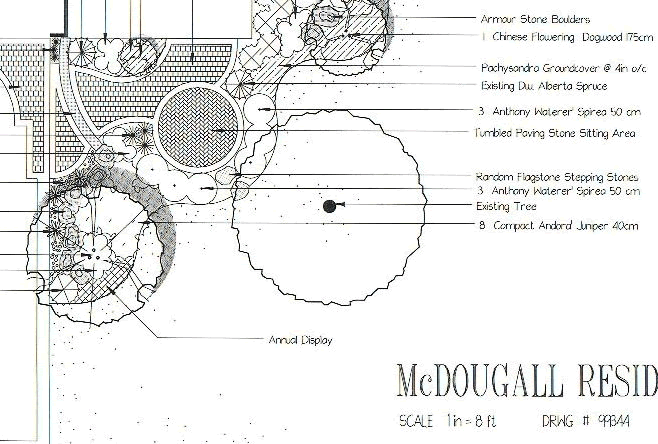
Planting plan, as plants are selected draw or sketch their location on a plan.
Below are design tips on creating a basic planting plan:
| • | Begin by placing trees, large shrubs, and foundation plantings in key positions to form the overall scheme. These large, woody plants are needed in the garden. Without them, the garden appears flat and uninteresting; particularly during the winter season as the smaller, deciduous shrubs and most perennials may be bare and dormant. |
| • | Foundation planting (shrubs located at the base of your home) is also a vital part of the plan. Foundation plants have historically been used to block the view of raised house foundations and to slow cold air movement under the house. Decorative aspects of this type of planting are to highlight the main entrance, compliment the architectural style of the home, break long, continuous lines, and blend the home into the surroundings. Be careful to choose plants that will not be too high and/or wide at maturity. |
| ▪ | A general rule of thumb is that the plant height should not exceed two-thirds of the height of the wall at the corner of the house. |
| ▪ | Generally, plant height should not exceed the height of a line extending from the doorway to this imaginary point at the house corner. |
| ▪ | Planting too close to the house is most common error. Whatever the radius of the plant will be at maturity would be the same distance the plant should be placed from the foundation. If the tree you are planting will have branches reaching a distance of 10 feet from the trunk, then that tree needs to be planted at least 10 feet away from the foundation of the house. This will allow room for the plant to grow properly, allow adequate air circulation near the house, and possibly prevent damage to the foundation as the tree matures. Check with your energy provider for types of trees to plant under power lines |
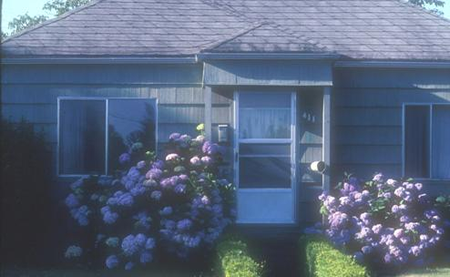
The Hydrangea plants, while lovely, are planted too closely to the house
foundation, overwhelming its façade and the low boxwood hedges.
| • | Once trees, large shrubs, and foundation plantings have been chosen, add plants that will be used for screening or partitions, such as hedges, vines, or espaliers. Plants provide an inexpensive, interesting and colorful screen. Living plant screens can be combinations of raised landform, ground covers, small shrubs, large shrubs, and trees. This combined planting is especially suited for noise abatement where the lot adjoins a busy street. |
| • | Next, it is time to add the smaller plants such as low-growing shrubs, vines, and perennials. Arrange these plant types in groups of like species to create a mass effect. Space like plants at a distance slightly less than mature width. Space different plant types at mature width plus another foot or more; this will create a clean looking design, reduce the need for pruning, and improve health by providing good air circulation. Keep in mind that massed plants can be susceptible to insect infestation such as mites and scales (usually due to poor air circulation). |
| • | To tie the planting plan together, add the ground covers (low-growing manzanita for sunny area and Ajuga for shade). Choose ground covers with low-maintenance in mind. If there will be leaf drop from deciduous trees and shrubs onto the ground cover, choose ground covers tolerant of raking and blowing. |
| • | Less is more in planting design. Complex designs usually require more maintenance. Simplicity can be achieved by avoiding unnecessary detail. For example, limit the number of plant species and create well-defined planted areas by not scattering plants throughout open areas. |
| • | Plant shrubs, as well as trees, according to their mature width and height. This will save you years of added maintenance costs and labor. |
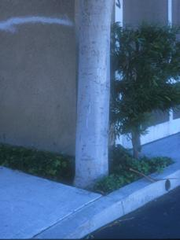
This tree will have to be removed
as its roots have encroached upon the
house foundation and sidewalk.
|
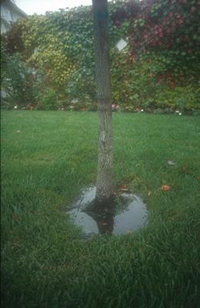
Trees are generally deep-rooted
whereas turf grass is not.
This can result in over-watering of the tree.
|
| • | Avoid planting trees in lawn. The water needs of a healthy lawn may adversely affect the health and longevity of the tree. |
| • | Consider how much lawn you would like or need. Create functional or recreational turf areas and avoid using ornamental lawn areas. Place lawn where it will be used, or forgo lawn altogether (it is usually the highest water-consuming plant in a garden), and consider lawn alternatives, such as groundcovers or permeable hardscapes. Turf might not be a wise or appropriate plant selection on slopes, particularly where the toe of the slope is adjacent to an impermeable hardscape and overhead sprinklers are used. |
| • | The use of noxious and /or invasive plant species is strongly discouraged. Check the California Invasive Plant Council for more information about invasive species. ( www.cal-ipc.org ) |
| • | Be sure the angle at lawn corners is no less than 90 degrees. Generally, it is difficult to effectively irrigate a narrow area of turf without flooding. |
| • | If you enjoy seasonal color, consider container gardens with lush, luxurious and low-maintenance ornamentals and grasses. |
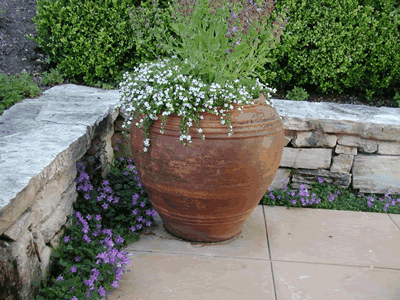
Perennial plants in container
| • | A year-round evergreen garden can be achieved with hardy, low-maintenance ground covers. |
| • | Long, narrow strips of bare ground can be planted with colorful, low-maintenance, water-thrifty perennials. |
| • | Consider an organic garden (also known as a natural or chemical-free garden). Organic gardening considerably lessens the need for chemical fertilizers and pesticides. It creates healthy soil, which in turn, promotes healthy plants less susceptible to disease and insects. |
| • | Remember your utility equipment when planning your design. Before digging call Underground Service Alert (USA) toll free at 800-642-2444 to locate utility lines. |
| • | Look for plants with the same hydrozone designation (water needs). Grouping plants with similar water needs allows you to precision water your garden. |
| • | Resist the need for instant gratification and avoid making an “instant” garden. This will cause over-crowding of plants. However, if you love to browse garden centers, native plant sales, and farmer’s markets for unusual plants, plan to dedicate an area in your garden for such spur-of-the-moment plant additions. |
| • | Buy healthy, well-rooted plants within your budget; not necessarily the biggest plants. |
| • | Keep in mind that the wrong plant or the wrong planting location is a recipe for an unhealthy, unproductive, unattractive, and costly landscape. Select plant varieties that are not only going to achieve the desired visual effect, but that are going to thrive where they are planted. |
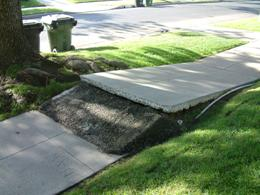
The tree at the edge of this photo has
surface roots that are pushing up the
sidewalk.
|

There is no soil left to grow other plants
due to the surface roots of the tree.
|
| • | To make your planting a success, choose plants well-suited by nature to the particular physical conditions in which they will be expected to grow. For example, a drought tolerant plant should not be planted in a west, shady area, because the plant will drown. |
The Plant List on the Main Menu is a great place to begin selection for your garden.
Parking Strips
If you have a parking strip (the area of land between the sidewalk and road) that is part of your property, be sure to consult with your local public works department about planting and maintaining the strip.
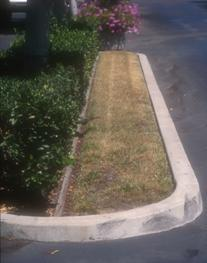
Overhead sprinklers are inappropriate
for parking strips and can cause
substantial water waste through
overspray and runoff. Narrow or
irregularly shaped areas, including turf,
less than ten feet wide in any
direction should be irrigated with
subsurface irrigation or low-volume
irrigation systems.
|
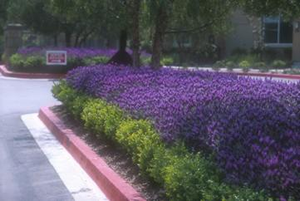
The lavender and the low Boxwood hedge are drip
irrigated and make an eye-catching and water efficient
display.
|
Traits to consider when choosing plants for parking strips:
| • | Persistent (bulbs, perennials, low shrubs) |
| • | Compact height (under 3 feet) |
| • | Tidy growth (little pruning needed) |
| • | Variety of textures and shapes |
| • | Flower colors to suit your taste |
|
